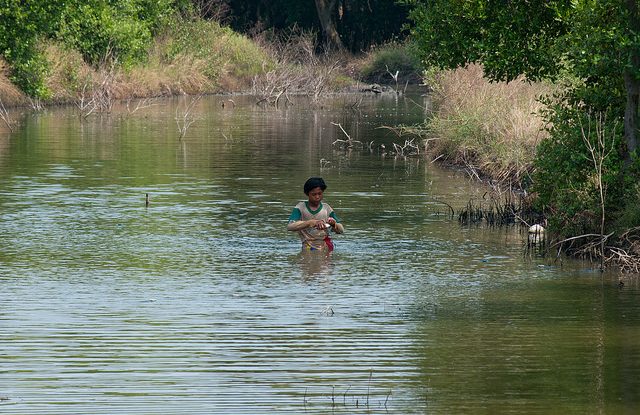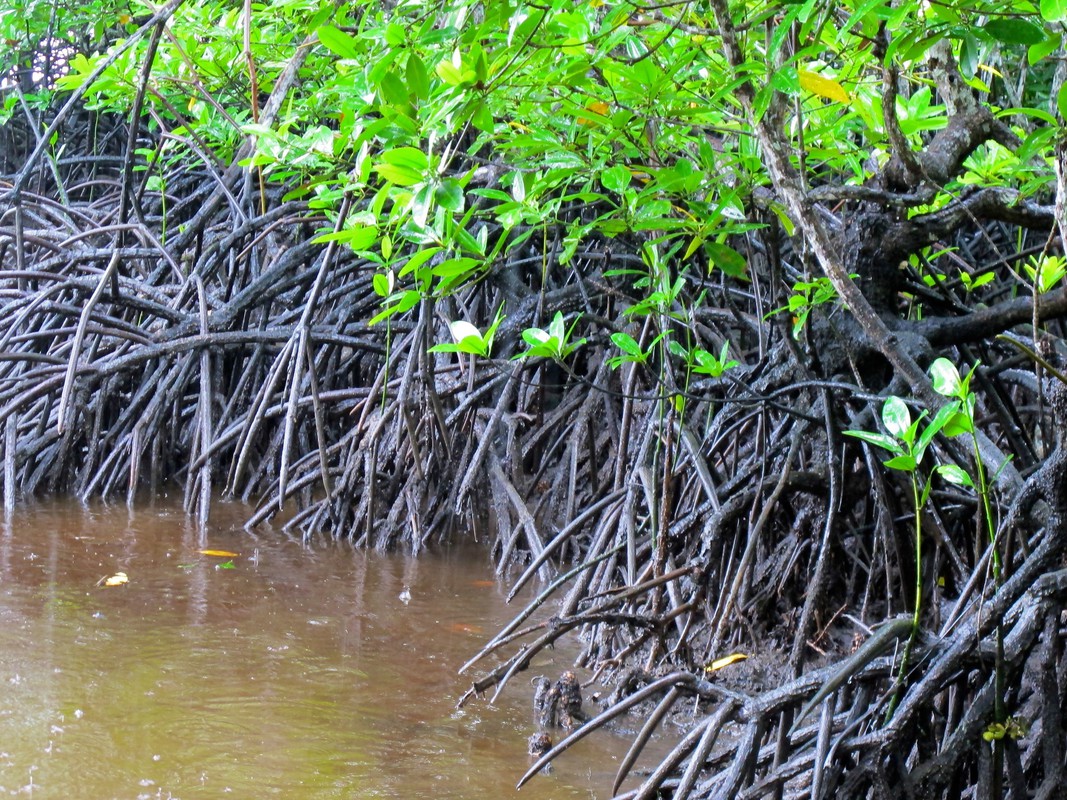
On December 26, 2004, a magnitude 9.1 earthquake off Sumatra, Indonesia, swept a massive tsunami across the Indian Ocean. The wave forged two kilometers inland in some places, and wiped out towns, crops, lives and livelihoods. In Indonesia’s Aceh province alone, 167,000 people died.
Could anything have reduced its devastating impact? In the tsunami’s wake, global attention fell on the potential of mangroves. Many of Indonesia’s mangrove forests had been cleared prior to 2004 to make way for shrimp farms – and subsequent research showed that mangroves and other forests can help protect coastlines and people from the force of tsunamis, hurricanes, and rising sea levels.
The indigenous people of Pahawang Island already knew that, though. In the 1980s and 1990s, the mangrove forests fringing their island – a speck in a bay at the eastern end of Sumatra – were over-exploited. They were turned into charcoal by Korean companies, cut down for timber, and converted to fish-ponds by migrants from East Java.
By the early 2000s, coastal erosion had become a huge problem for the islanders. Houses, agricultural land and fish-ponds were swept away in storms; fish no longer bred amongst the looping mangrove roots; and malaria and dengue outbreaks became more common.
So village leaders got together and pioneered their own, innovative governance system for their mangroves. They developed an organizational structure, and divided the mangrove area into three territories – a strict protection zone, an area where only non-timber products like firewood could be gathered, and a ‘utilization zone’ where limited timber harvesting was allowed. They also identified areas for reforesting, and secured seedlings and funding.
There’s much to be learned from local experiences like these, say scientists from the Center for International Forestry Research, who have just released a new global study on mangrove governance, involving both a review of international literature and case studies in Indonesia and Tanzania.
BENEFITS OF A BOTTOM-UP APPROACH
“In Indonesia they were very clear: they managed their mangroves to protect their lives, livelihoods and assets from storm surges, from the sea,” says Esther Mwangi, who helped lead the overarching study. “The mangroves are an important buffer against the energy and the strength of the ocean.”
Mani Ram Banjade led the on-the-ground research in Indonesia, focusing on three villages in Lampung province.
In Pahawang especially, mangrove protection was a very bottom-up affair.
“The local community leaders took the initiative and developed their own rules, regulations and governance mechanisms. Then they got the approval from the local government as well, and from their personal and political connections they also got some resources from outside.”
It worked so well in Pahawang, he says, because the local government recognised the islanders’ rights over the land and supported their efforts – and because strong leaders harnessed community awareness of the role of mangroves in coastal protection.
“Even if they’re not getting a direct economic benefit from the mangrove, they still value its conservation,” says Banjade.
“It’s a good model,” says Steven Lawry, CIFOR’s Director of Forests and Governance Research, who also worked on the report. “This is an example of how strong leadership and persistence have led to good outcomes with respect to local mangrove conservation. People are out there up to their waists in water, planting mangroves, because they see the importance to their livelihoods.”
BREAKING THE SILOS
In many places worldwide, these kinds of bottom up approaches to governance are necessary, because mangroves often fall through the cracks at the national level, says Mwangi.
Washed by the tides, simultaneously of the land and of the sea, mangroves don’t neatly fit into governance structures. Globally, it’s rare for countries to have specific rules for mangroves. They’re either governed under a hodgepodge of two or three ministries, or they fall under the forestry department.
That isn’t a perfect match, says Mwangi.
“In mangrove forests, the timber is not the biggest thing – the value is in coastal protection, fisheries, carbon sequestration – things that are not forestry. And yet this resource has been placed in the hands of forestry departments. So there is a bit of a tension.”
Where governance is spread among multiple ministries, coordination is a problem. And many efforts to improve it have failed. Indonesia put together a mangrove management and coordination plan in 2012 – but it hasn’t yet been fully implemented.
Even more telling is the case of Tanzania. In 1991 it was one of the first countries to create an integrated management plan for mangroves – and yet to date, 25 years on, it too has not been implemented.
The reasons behind these failures is a prime area for future research, says Mwangi – but perhaps a better approach, she suggests, would be to bring in new legislation that is specific to mangroves, like the rules pioneered on Pahawang.
“One could easily say the village regulations are substituting for a national, mangrove-specific regulation that is missing,” says Mwangi.
GENDER DYNAMICS IN CONSERVATION
Something that’s lacking at all levels – from fishing village to academia – is an appreciation of gender dynamics.
“In the literature review there was hardly anything on gender, and then when we looked at the ground level we saw exactly the same thing – a widespread gender blindness in mangrove management.”
People’s relationships to mangroves are gender-differentiated, Mwangi says. Women might gather firewood, while men harvest timber and fish.
In the literature review there was hardly anything on gender, and then when we looked at the ground level we saw exactly the same thing – a widespread gender blindness in mangrove management.
Yet in both Tanzania and Indonesia, women rarely sat on management committees, and their participation in decision-making was curtailed in a number of ways.
In Tanzania, researchers found that meetings were often organized in the late afternoon, when most women were fetching firewood and water to cook the evening meal. When women were present, social customs dictated they sit behind the men and ‘say yes to everything’, even when they disagreed.
“Not only as a matter of right, but also in terms of being effective, it makes sense to have women on governance committees,” says Mwangi. “They too have knowledge and use the resource, so their presence and input in decision-making is important.”
Gender aside, there’s a lot national governments can learn from the innovative ways local communities are managing their mangroves. And it’s crucial those villages receive support and assistance to do that from regional and national bodies, Mwangi says.
“With good local leadership and support from others at different levels of government, communities can organise, develop rules and can work together to conserve their mangroves.”
Despite government intentions to manage them sustainably, governance regimes are generally ineffective at conserving mangroves. They generally fail to involve communities, and at the same time they don’t effectively regulate large-scale commercial users of mangroves, with a result that mangrove loss is accelerating."
The study found that a transition is underway in a few countries towards increased community participation in mangrove management. Though Latin America has been most enthusiastic, Tanzania’s government is also starting to experiment with community-based approaches in some mangrove areas, says Lawry.
That is encouraging, he says, because the traditional model of mangrove governance – strict top-down regimes that try to protect mangroves by locking local people out – hasn’t worked very well, in Tanzania, Indonesia and elsewhere.
“Despite government intentions to manage them sustainably, governance regimes are generally ineffective at conserving mangroves. They generally fail to involve communities, and at the some time they don’t effectively regulate large-scale commercial users of mangroves, with a result that mangrove loss is accelerating,” he says.
“Where we do see progress towards sustainable mangrove management, it’s in places where communities have clear rights, and they enjoy clear benefits.”
*This research was supported by USAID
We want you to share Forests News content, which is licensed under Creative Commons Attribution-NonCommercial-ShareAlike 4.0 International (CC BY-NC-SA 4.0). This means you are free to redistribute our material for non-commercial purposes. All we ask is that you give Forests News appropriate credit and link to the original Forests News content, indicate if changes were made, and distribute your contributions under the same Creative Commons license. You must notify Forests News if you repost, reprint or reuse our materials by contacting forestsnews@cifor-icraf.org.

